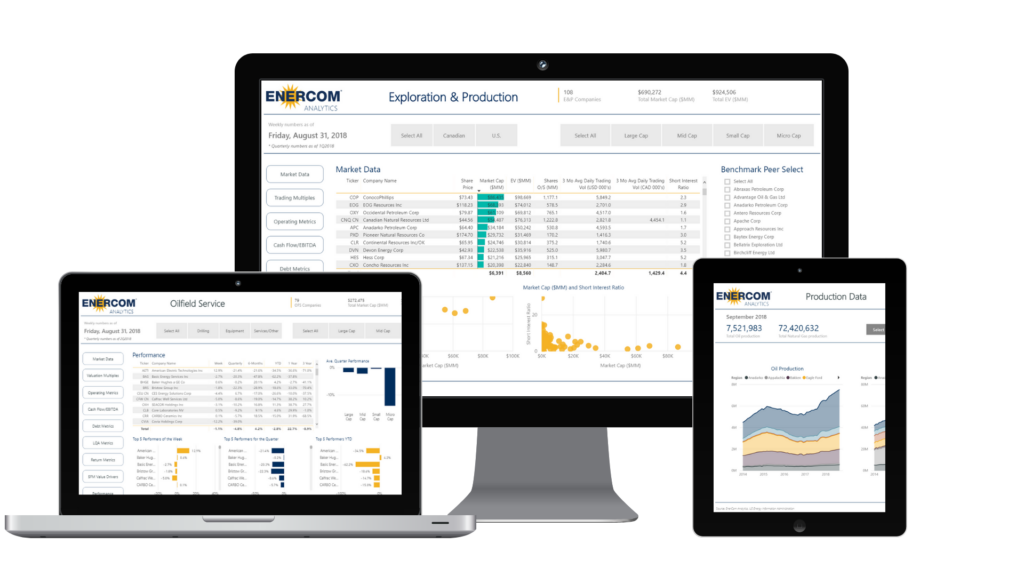EnerCom, Inc. compiled fourth quarter earnings per share, revenue, EBITDA and cash flow per share analyst consensus estimates on 191 E&P and OilService companies in our database. Click here for the full chart of estimates.
The median OilService company earnings estimate for the quarter ending December 31, 2012, is $0.31 per share compared to actual earnings per share of $0.31 and $0.22 for Q2’12 and Q3’12, respectively. The median E&P earnings estimate for the quarter ending December 31, 2012, is $0.19 per share compared to actual earnings per share of $0.21 and -$0.02 for Q2’12 and Q3’12, respectively.
ENERGY COMMODITY PRICES
WTI oil price averaged $88.17, $92.16, and $93.30 per barrel during Q4’12, Q3,12 and Q2,12 respectively, while the Henry Hub natural gas price averaged $3.40, $2.88 and $2.29 per MMBtu over the same time periods. The average price for a barrel of WTI in Q4’11 was $94.03; for natural gas it was $3.33 per MMBtu.
Crude Oil. The average near-term futures price for WTI in December 2012 increased to $87.97 per barrel or 0.7% higher than the prior month, but -10.6% lower than the same month last year. The five-year strip at year-end 2012 was $90.08 per barrel.
The average price of gasoline (all grades, all formulations) in December 2012 was $3.38 per gallon, -4.0% lower than the previous month and 1.7% higher than the same month last year.
Brent crude continued to trade at a premium to WTI, as it has since Q3’10. In December 2012, the average near-term futures price for Brent was $109.20 per barrel, -0.3% lower than the prior month and 24% higher than the WTI near-month futures price. Brent in December 2012 was -6.8% lower than the same month last year.
The median analyst estimate at the beginning of January for 2013 NYMEX oil was $91.00 per barrel with a high of $115.00 per barrel and a low of $65.00 per barrel.
[sam_ad id=”32″ codes=”true”]
Natural Gas. Rising production combined with the warmest year ever recorded for the United States led to continued oversupply in the natural gas market. Despite rising demand from the power generation and industrial sectors, 2012 gave us a stark reminder that natural gas prices are still largely supply-driven and a decline in the natural gas rig count has yet to make a material difference in rebalancing the supply-demand equation.
In October 2012, total natural gas consumption was 60.9 Bcf/d, up 1.6% from the prior month and 8.5% higher from the same month last year. For the first ten months of 2012, natural gas consumption was 4.5% higher than the same period in 2011. By consuming sector: industrial (+2.5%), commercial (-10.9%), power generation (+23.8%) and residential (-16.2%).
The average near-term futures price for Henry Hub in December 2012 increased to $3.44 per MMBtu or -6.7% lower than the prior month, but 6.0% lower than the same month last year. The five-year strip at year-end 2012 was $4.20 per MMBtu.
Stronger oil prices and weaker natural gas prices combined to keep commodity prices decoupled on an energy-equivalent basis, as the spot price for oil as of December 28, 2012 traded at 26.5 times the equivalent natural gas price, more than the standard 6:1 energy equivalent ratio. We note that the ratio has closed as oil prices have declined and natural gas prices have increased.
Rig Count — Natural Gas Rig Count Declines. The U.S. land rig count sourced from RigData on December 28, 2012, stood at 1,748 rigs, a decrease of 249 rigs from Q3’12. The aggregate decrease resulted from a reduction in rigs drilling for gas (-52), gas/oil (-97), oil (-89) and other (-11).
On December 28, 2012, there were 1,058 horizontal rigs in the U.S., a decrease from 1,161 in Q3’12. On December 28, 2012, the number of horizontal rigs targeting natural gas exclusively dropped from December 31, 2011 by 183 rigs to 213 for a decline of 46%. The number of rigs targeting oil exclusively increased from December 31, 2011 by 23 rigs to 221 for an increase of 12%.
By play and as compared to Q3’12, rig count changes include Haynesville (-3 rigs, or -8.3%), Fayetteville Shale (-2 rigs, or -2%), Woodford Shale (-2 rigs, or -29%), Appalachian Basin (-2 rigs, or -1.4%), Williston Basin (-32 rigs, or -16%), Eagle Ford Shale (-29 rigs, or -12%), DJ Niobrara (-10 rigs, or -36%), Permian Basin (-66 rigs, or -15%).
 By region and as compared to Q3’12, horizontal rig count increases occurred in Alaska (+1 rigs from 0), East Texas and North Louisiana (+5 rigs, or +11%) and Northeast (+9 rigs, or +7.3%). Declines were in Midcontinent (-18 rigs, or -7.0%), North Texas (-11 rigs, or -25%), Rockies (-44 rigs, or -16%), South Texas (-24 rigs, or -16%), Texas Gulf Coast (-12 rigs, or -10%) and West Texas and New Mexico (-8 rigs, or -5.3%). As of the week ending December 28 2012, 61% of working rigs were drilling horizontally, up from 58% in Q3 2012 and 57% in Q2 2012.
By region and as compared to Q3’12, horizontal rig count increases occurred in Alaska (+1 rigs from 0), East Texas and North Louisiana (+5 rigs, or +11%) and Northeast (+9 rigs, or +7.3%). Declines were in Midcontinent (-18 rigs, or -7.0%), North Texas (-11 rigs, or -25%), Rockies (-44 rigs, or -16%), South Texas (-24 rigs, or -16%), Texas Gulf Coast (-12 rigs, or -10%) and West Texas and New Mexico (-8 rigs, or -5.3%). As of the week ending December 28 2012, 61% of working rigs were drilling horizontally, up from 58% in Q3 2012 and 57% in Q2 2012.
Equity Markets. In December 2012, the S&P 500, XNG, XOI and OSX changed by 0.7%, 0.6%, 2.1% and 0.8% month-to-month, respectively. The S&P 500 had the largest year-over-year increase gaining 13.4%.
From EnerCom’s E&P Database: For December 28, 2012 year-to-date large-cap, mid-cap, small-cap and micro-cap E&P stocks lost 4.2%, 7.7%, 16.7% and 22.7%, respectively. Year-to-date, oil-weighted companies lost 7.6% while gas-weighted companies finished down 18.7%. By region as of December 28, 2012 year-to-date, Bakken, Midcontinent, Diversified and Gulf of Mexico stocks lost 8.5%, 19.0%, 1.6% and 1.1%, respectively.
From EnerCom’s OilService Database: As of December 28, 2012 year-to-date, OilService small-cap stocks gained 3.7%, while large-cap, mid-cap and micro-cap stocks lost 0.3%, 1.3% and 0.7%, respectively.
Expected Themes for Conference Calls
Below are some themes and thoughts we expect to take prominence on this quarter’s conference calls.
OilService Companies:
- Rig Count – Has the U.S. rig count finally bottomed?
- How are companies working through their equipment inventories? Are certain basins tight with inventory and others loose?
- International margins vs. North American margins – Where’s the money at?
- Trends and outlook on dayrates and backlog (onshore and offshore drillers)
- LNG off-take opportunities
- Global economic outlook – how are the multi-nationals thinking downfield?
- Offshore new builds (FPSOs, etc.)
- Onshore new builds – rigs, horsepower, frac spreads
- Balance sheet strength and liquidity – “Dear 8 pound, 6 ounce Baby Jesus, please give us another boom!”
- Deepwater activity – Ken Salazar is retiring. Will the GOM come ripping back!?
- Canadian winter drilling season. Hockey and drilling in Canada
E&P Companies:
- 2012 reserves – additions, acquisitions, revisions
- 2013 commodity price outlook – Are E&P companies grim about 2013 oil and natural gas prices?
- Efforts to tighten crude differentials – How are new pipeline expansions are addressing the issue? What happens to LLS crude prices if EVERYONE is shipping their crude to that off-take point?
- 2013 CAPEX budgets – How are E&P companies allocating capital to projects?
- Midstream contracts and take-away capacity
- Debt deals/redeterminations
- Balance sheets/liquidity positions
- Drilling efficiencies
- New play activity (Brown Dense, Tuscaloosa, Utica, Mississippian, Pearsall, Heath, etc.)
- Down spacing opportunities
- Natural gas and crude oil hedging strategies
Important disclosures: The information provided herein is believed to be reliable; however, EnerCom, Inc. makes no representation or warranty as to its completeness or accuracy. EnerCom’s conclusions are based upon information gathered from sources deemed to be reliable. This note is not intended as an offer or solicitation for the purchase or sale of any security or financial instrument of any company mentioned in this note. This note was prepared for general circulation and does not provide investment recommendations specific to individual investors. All readers of the note must make their own investment decisions based upon their specific investment objectives and financial situation utilizing their own financial advisors as they deem necessary. Investors should consider a company’s entire financial and operational structure in making any investment decisions. Past performance of any company discussed in this note should not be taken as an indication or guarantee of future results. EnerCom is a multi-disciplined management consulting services firm that regularly intends to seek business, or currently may be undertaking business, with companies covered on Oil & Gas 360®, and thereby seeks to receive compensation from these companies for its services. In addition, EnerCom, or its principals or employees, may have an economic interest in any of these companies. As a result, readers of EnerCom’s Oil & Gas 360® should be aware that the firm may have a conflict of interest that could affect the objectivity of this note. The company or companies covered in this note did not review the note prior to publication.






